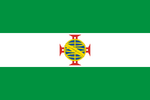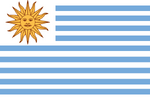The flag of Uruguay consists of nine equal horizontal stripes of white (top and bottom) alternating with blue; a white square (of five stripes in width) in the upper hoist-side corner with a yellow sun bearing a human face known as the Sun of May with 16 rays that alternate between triangular and wavy.[2]
Symbolism[]
The flag effectively combines a symbol of Argentina (the Sun of May, colour scheme) with the flag pattern of the United States (stripes and canton).
The nine horizontal stripes on the flag represent the nine original counties: Montevideo, San José, Colonia, Soriano, Paysandú, Cerro Largo, Maldonado, Canelones, and Durazno.
Nickname[]
- Sun and Stripes
- Sol y rayas
Alternative national flags[]
Uruguay is one of few countries which has adopted three flags as national symbols:
- El Pabellón Nacional — the National Flag (the main national symbol), as described above.
- La Bandera de Artigas — Artigas's Banner, after national hero José Gervasio Artigas, traditionally used as the symbol of the military of Uruguay.
- La Bandera de los Treinta y Tres Orientales — the flag of the Thirty-Three Easterners, a militant revolutionary group which fought against the Empire of Brazil.
All the three flags are flown together during national holidays and other special occasions.[3]
The country has a special naval jack (el pabellón de proa), used also as the Navy's Flag. The jack consists of a white field, with a thick blue saltire, and a stylized Uruguayan sun in the center.
History[]

Cisplatina Province,
July 17, 1821 – August 26, 1825

1828-1830
The area became the Provincia Oriental in 1813 as part of a federal league of provinces, the Liga Federal. The Liga was then invaded by Portugal in 1816 and then dissolved four years later, with its provinces beginning the process of integration into the United Provinces.
In 1821 the Provincia Oriental was re-annexed by Portugal under the name of Província Cisplatina. After Dom Pedro I declared the independence of Brazil, the Província Cisplatina became part of the Empire of Brazil.
The first national flag was adopted by Uruguay on December 18, 1828, when it obtained recognition from both Argentina and Brazil (which earlier claimed its territory). Originally the flag had nine blue stripes to symbolise the number of counties. The number of blue stripes was reduced to four in the flag law of July 11, 1830, which is still in effect. The symbolism of the nine original departments is now expressed by both blue and white stripes, rather than the blue stripes alone.[4]
References[]
South America
|
|---|
| Nations Territories |




